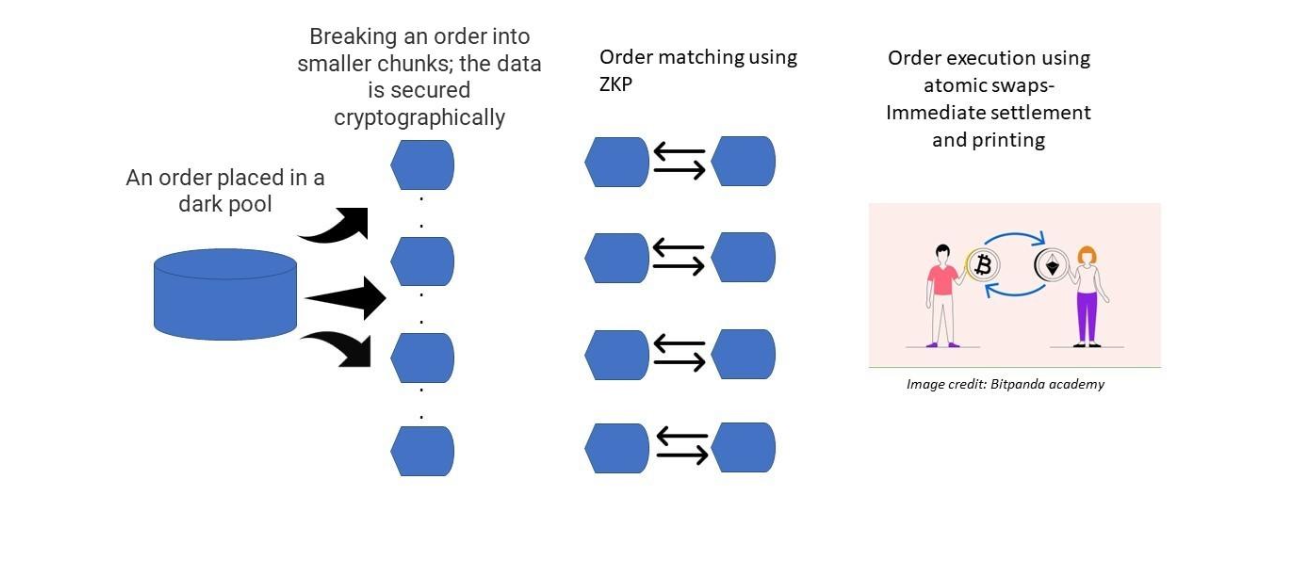Dark pool trades are an excellent indication of what’s really going on in the market.
Markets have always been more than what is shown to the public eye. They are complex and dynamic environments that are affected by many factors, including those happening behind the scenes. The crypto market is not an exception here.
It’s not that I’m inviting you to start looking at things through the conspiracy theory lenses. My point is just that the markets’ pictures are always bigger than we see them. There is always something that remains on the periphery of our perceptions as we don’t know much about it.
While dark pool trading is deemed not to affect market prices, big money moves still can't be completely impartial to it.
An example is when Elon Musk's Tesla sells high-risk assets publicly, the market hears and reacts.

Dark pool trading is a great benchmark here. Not so many market players have access to them. However, they deal with big money and can’t but impact the entire market ecosystem.
Dark pools have been existing for a while in traditional markets. Now they are coming onto the crypto scene.
So let’s look at what dark pools essentially are, how strong their presence is on the crypto market, and whether they can come in handy for a deeper understanding of the market’s vibe and trends.
What is a dark pool, and why is it dark?
A dark pool is an alternative trading system (ATS) or a marketplace for anonymous off-exchange trades. Unlike a regular exchange where all your bids and asks are open to the public eye right after they are placed in a dark pool, they would become visible sometime later after they have been filled.
Let’s say you’ve made a trade in a dark pool — other pool participants will learn about it a few hours later or even on the next day. In other words, your trade will leave a post-factum “print” on the dark pool’s dashboard.
That’s what prints look like in general:

Summing up, the “darkness” of dark pools means the following:
- information on trades comes in a delayed manner in the form of buy/sell prints;
- a print doesn’t contain much information about a trade. Essentially, it only indicates the quantity, price, and currency of trade; prints are deemed available only for dark pool participants. However, there are some methods to spot them indirectly (i.e., through dark pool scanners, financial reports, news, and the like).
What’s the purpose of a dark pool?
Dark pools are tailored for large-scale traders, i.e., primarily institutions and whales.
The purpose here is to enable them to trade in big sizes off the public market and therefore avoid causing extreme volatility in assets’ market prices.
Imagine someone is placing an X-million dollar order on an exchange. Will it cause anxiety or panic in other participants? Chances are, it will! Because there is a general belief that big players always know more than the rest. This is why they sell or buy at a particular moment.
So to avoid bringing chaos to markets, a whale would be better off going to a dark pool. Besides this, they would also be able to
- stay relatively confidential with their trades
- transact with lower slippage (unless they use market orders)
- get a better price for assets, and
- save on transactional costs.
Seriously, dark pools don’t affect asset prices at all?!
Theoretically, they shouldn’t. But if we approach the market as a living and wholistic organism, it’s impossible that big trades would remain neutral to it.
Over-the-counter trading doesn’t mean trading in a vacuum, agree?
However, in the case of dark pools, the effect of big moves is delayed. It would be more correct to say that dark pool trading does impact the market but in a smooth and caring manner.
What Are Crypto Dark Pools?
In the crypto market, we have dark pools as well. Unlike conventional pools, cryptos are not currently subject to any sort of scrutiny from security agencies or other regulatory bodies. Therefore they are not on any official register that could indicate how many exist so far.
Basically, crypto dark pools work similarly to the stock market pools: they match buyers and sellers for large orders without a public order book. As you might have guessed here, the main difference is the specific asset type (i.e., crypto) and the technology behind blockchain.
Types of dark pools in crypto
Roughly, there are two types of crypto dark pools: centralized and decentralized.
Centralized dark pools
Current centralized dark pools exist as “special features” of crypto exchanges or other types of trading apps.
To explore a dark pool, one must pass verification and create a separate PRO or Business-type account. While trading, an app can offer you to choose the destination of your order — a public order book or a dark pool.
Examples of centralized crypto dark pools:
- sFOX, and
- Kraken Dark Pool.
Decentralized crypto dark pools
In fact, a decentralized crypto dark pool is a DEX (decentralized exchange) but with the difference that it is tailored for large-scale players and enables anonymous trading.
Conceptually, a decentralized dark pool can have the following features:
- Order chunking. When a trader places a buy/sell bid, it automatically breaks down into several smaller chunks that are distributed among a network of independent nodes (i.e., dark nodes). Such chunking allows hiding the original order and the trader’s identity. It also helps avoid price plummeting, which would be inevitable if a large order was placed once in full size.
- Validation by nodes. The nodes verify that the chunks belong to the same order and validate transactions with it.
- Use of cryptographic mechanics in order matching. Examples of such mechanics are multi-party computation (MPC) and zero-knowledge proofs. Their primary purpose is to enable transactions without revealing parties’ details such as wallet address and exchange.
- Use of atomic swaps for cross-chain trading.
- Implementation of tokens incentivizes to stimulate users’ retention and loyalty. For example, a dark pool’s tokens can grant users some commission discounts or let them harness the exclusive pool’s features.
Here is how a decentralized crypto dark pool works schematically:

Example:
- Ren (formerly Republic Protocol)
Pros of Crypto Dark Pools
While currently, there are not many crypto dark pools out there, we can talk about their merits mainly from a theoretical standpoint. So the outcomes that these pools are designed to bring are as follows:
- Execution of large trades without adverse effect on digital assets’ market prices.
- Protection against front-running activities of malicious traders. I explained this in more detail in my previous article on HFT crypto trading — check out the “sandwich attack” section.
3. Reduced slippage: as decentralized dark pools allow to break down large orders into smaller chunks and fill them partially, traders may trade with lower slippage.
4. Better execution price.
5. Privacy: currently, crypto dark pools are not subject to any regulatory requirements and imply almost zero information disclosure about parties and trades.
6. Decentralized crypto dark pools entirely comply with the DeFi standard, enabling p2p trustless anonymous transactions backed up by the blockchain record.
Cons of Crypto Dark Pools
- Exposure to the same risks as on CEXs/DEXs. To avoid repetition, I would refer here to my long read “Major Weak Points Of Crypto Exchanges That Create Unprecedented Risks For Traders,” which dissects all those risks in every detail. Welcome to check it out.
- Due to the lack of regulatory requirements on trades’ reporting applicable to crypto dark pools and their technological designs enabling complete anonymity, most market participants would not be able to understand the market’s sentiments and trends comprehensively. Only big guys would. What can this potentially lead to? Right! To a variety of ways of market manipulation.
What are the perspectives of dark pools in crypto?
Meanwhile, there are no official statistics or substantial analytics that would allow making any info-backed conclusion. However, we can still try to make some predictions based on what we have so far.
Here is my train of thoughts on it.
As we know, the institutional adoption of crypto is gaining momentum. The more “big guys” would come onto the crypto scene, the bigger would be the demand for “over-the-counter” type of trading venues wired for large-scale transactions with crypto.
As most institutions are subject to various regulatory requirements, including those on trades’ reporting and financial information disclosure, sooner or later, crypto dark pools, to some extent, would get more transparent. If so, they will get traced with “scanners” and other professional analytical tools, helping, in the end, get a more comprehensive and deep understanding of the market’s sentiment and where it is headed.
So the time will show. Let’s keep watching!
Final thoughts
Crypto dark pools don’t have much exposure right now. However, as the crypto market matures and starts resembling the traditional one in many aspects, the chances are that in the not too distant future, dark pools may evolve and become an integral element of the DeFi ecosystem. After all, there are already enough reasons to anticipate that.
Learn Web3 & Dive into DeFi with Yellow Network!
Yellow powered by Openware is developing an unprecedented worldwide cross-chain P2P liquidity aggregator Yellow Network, designed to unite the crypto industry and provide global remittance services actually helpful to people.
Are you a crypto developer? Check out the OpenDAX v4 white-label cryptocurrency exchange software stack on GitHub, designed to launch market-ready crypto exchange brokerage platforms with a built-in liquidity stream.

Join the Yellow Community and dive into the most product-oriented crypto project of this decade:
- Follow Yellow Twitter
- Join Yellow Telegram
- Check out Yellow Discord
- Find us on Hacker Noon
Stay tuned as Yellow Network unveils the development, technology, developer tools, crypto brokerage nodes software, and community liquidity mining!






































